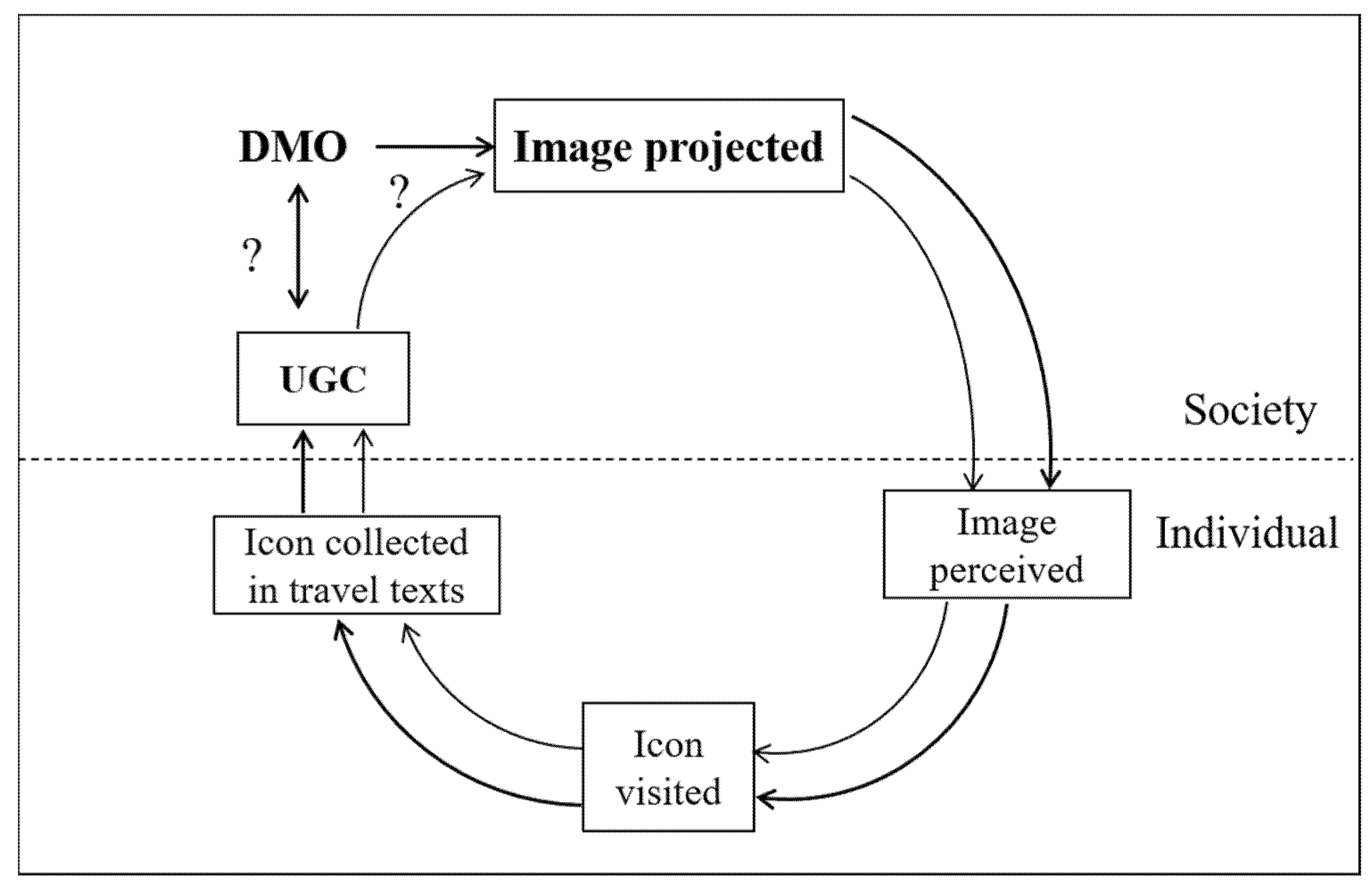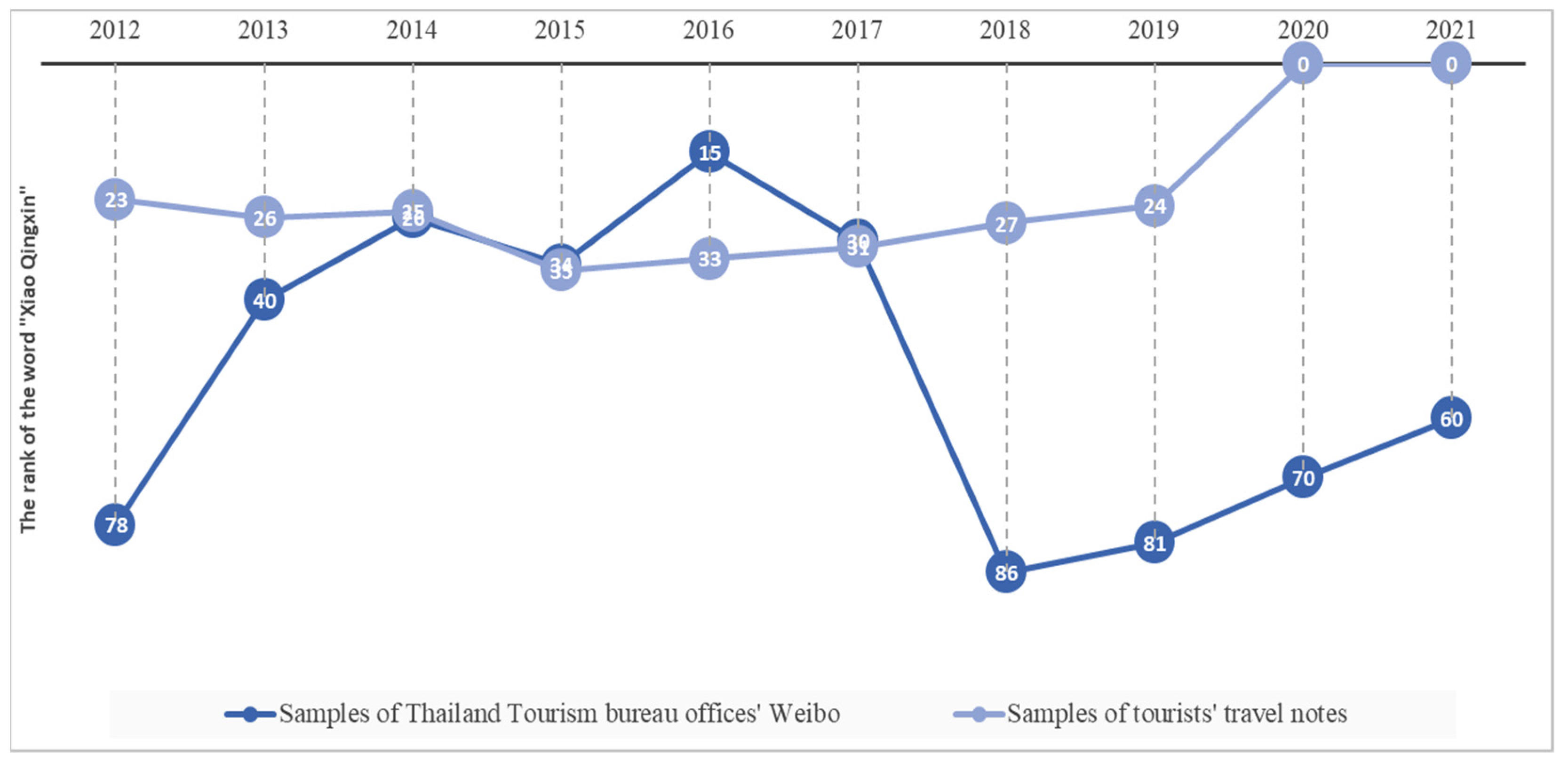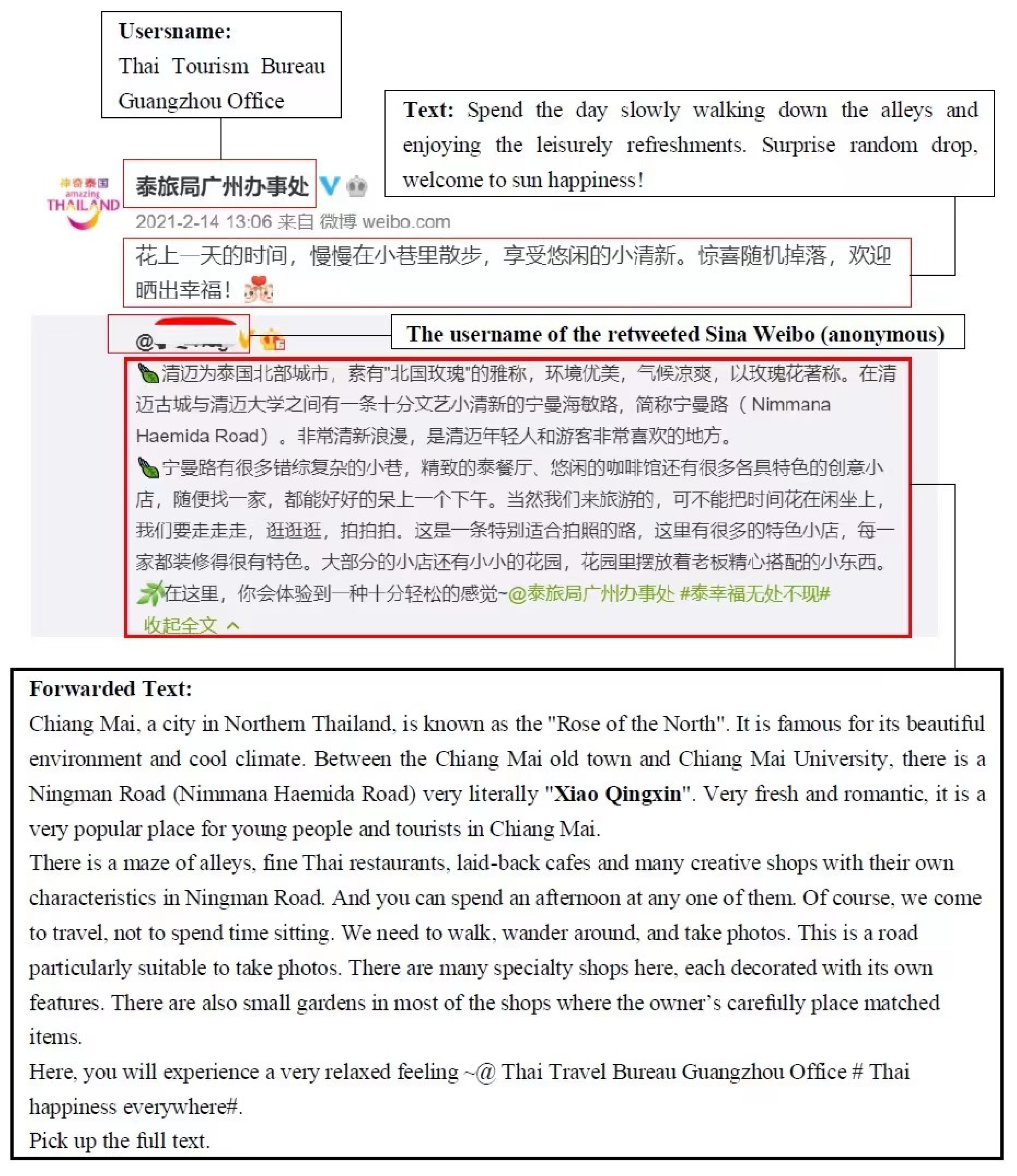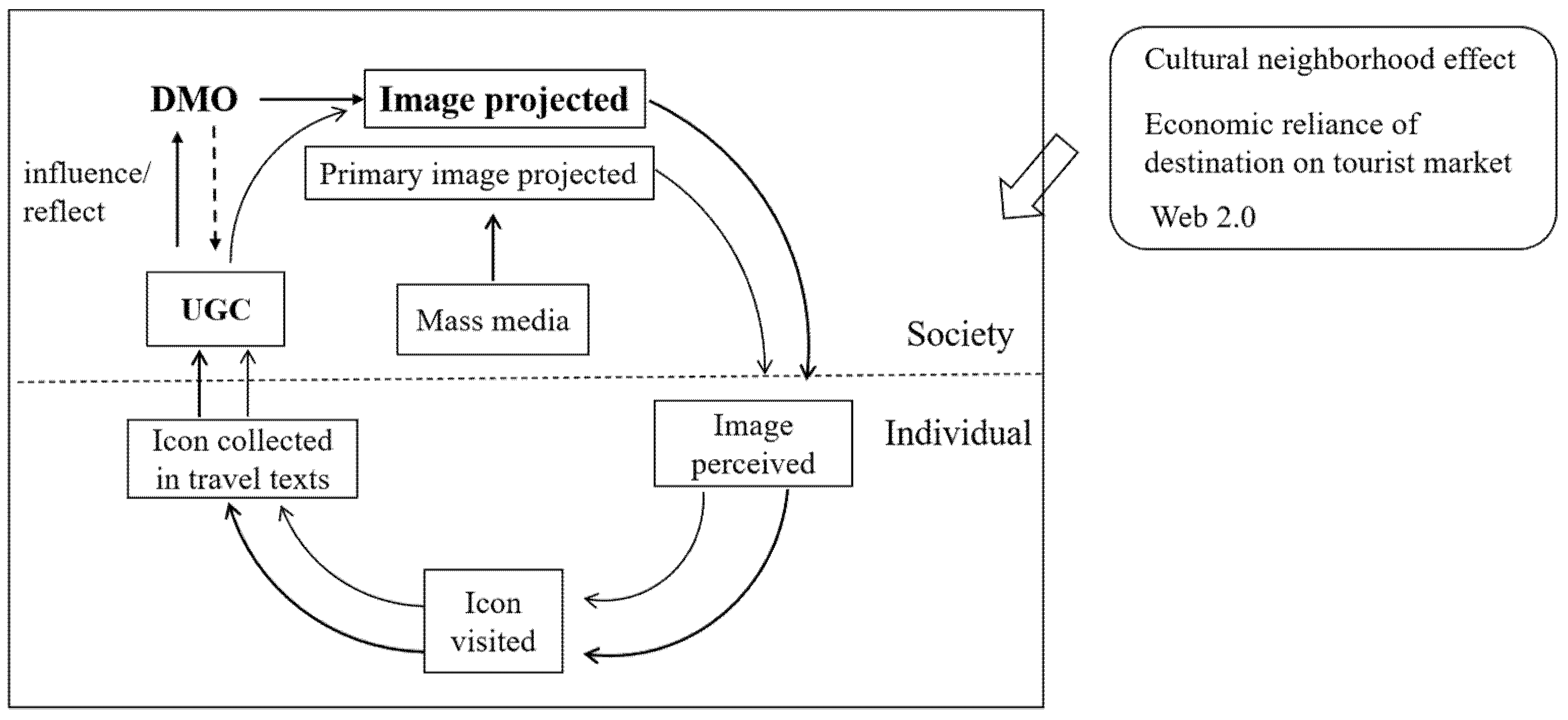Sustainable Tourism Destination Image Projection: The Inter-Influences between DMOs and Tourists
Abstract
:1. Introduction
2. Literature Review
2.1. Tourism Destination Image
2.2. The Theoretical Perspective: “Circle of Representation”
3. Study Context
4. Method
4.1. Data Cozllection
4.2. Data Analysis
5. Findings
5.1. The Exploring Stage (before 2012): Blurred Image of Chiang Mai
5.2. The Developing Stage (2012–2016): Tourists Generate the “Xiao Qingxin” Image and the DMO Follows
Around 2012 to 2013, (Chinese) tourists came from the movie “Lost in Thailand”. As I told you, so many Chinese came to Chiang Mai. First time we don’t know each other, because you cannot speak Thai, and we cannot speak Chinese. We cannot communicate to each other. You don’t know, because in Chiang Mai, we have only the Thai and English… We try to communicate, try to speak to you in Thai and in English, but you don’t understand that…. So, I think the beginning is kind of complicated situation between us.(O02)
“After 2012, with the popularity of “Lost in Thailand”, Chiang Mai became more and more famous. “Xiao Qingxin” was first proposed by Chinese tourists visited Chiang Mai. While tourists share their experience on various online platforms, this title has gradually become popular, and has been widely adopted into the theme of the trip to Chiang Mai, Thailand”.(O03)
5.3. The Adjusting Stage (2017–2019): DMO’s Reformulation and Tourists’ Renewing of “Xiao Qingxin”
“The main publicity focusses during 2017 to 2019: food is the mainstay supplemented by festivals, together with promoting the of historical sites. Festival promotion is focused on “Lanna culture”, “Loy Krathong” and “Chiang Mai Creative Week”. The goal is to create a holiday destination of food and culture. Over these years, there has been no change in this strategy. The importance level from high to low is cuisine, festival culture, historical sites and natural attractions”.(O03)
5.4. The Returning Stage (from 2020-): DMO’s Reprojection of “Xiao Qingxin”
“We welcome you because that Thailand, in Chiangmai, the main income came from tourism. So, we welcome every people who come to visit us… Now we miss you (Chinese) much. Please come to Thai”.(O02)
When you visit there (Chiang Mai), it is a “Lanna” image in clothes, architecture, in each aspect. Then if connecting Xiao Qingxin with Lanna Culture, can they be connected? In fact, there seems a certain correlation, because the culture, the architecture, the, including the speaking accent is very gentle. In all aspects, there is really a little bit of fit between these two.(O01)
6. Discussion
7. Conclusions
Author Contributions
Funding
Institutional Review Board Statement
Informed Consent Statement
Data Availability Statement
Acknowledgments
Conflicts of Interest
References
- Hunter, W.C. The social construction of tourism online destination image: A comparative semiotic analysis of the visual representation of Seoul. Tour. Manag. 2016, 54, 221–229. [Google Scholar] [CrossRef]
- Kock, F.; Josiassen, A.; Assaf, A.G. Advancing destination image: The destination content model. Ann. Tour. Res. 2016, 61, 28–44. [Google Scholar] [CrossRef]
- Grosspietsch, M. Perceived and projected images of Rwanda: Visitor and international tour operator perspectives. Tour. Manag. 2006, 27, 225–234. [Google Scholar] [CrossRef]
- Ferrer-Rosell, B.; Marine-Roig, E. Projected Versus Perceived Destination Image. Tour. Anal. 2020, 25, 227–237. [Google Scholar] [CrossRef]
- Chan, C.-S.; Zhang, Y. Matching projected image with perceived image for geotourism development: A qualitative-quantitative integration. Asian Geogr. 2018, 35, 143–160. [Google Scholar] [CrossRef]
- Bui, T.L.H. Congruency between the projected and perceived tourism destination image of Vietnam. J. Int. Bus. Res. 2011, 10, 1–13. [Google Scholar]
- Briciu, V.A.; Nechita, F.; Demeter, R.; Kavoura, A. Minding the Gap Between Perceived and Projected Destination Image by Using Information and Communication Platforms and Software. Int. J. Comput. Methods Herit. Sci. 2019, 3, 1–17. [Google Scholar] [CrossRef] [Green Version]
- Andreu, L.; Bigné, J.E.; Cooper, C. Projected and Perceived Image of Spain as a Tourist Destination for British Travellers. J. Travel Tour. Mark. 2008, 9, 47–67. [Google Scholar] [CrossRef]
- Kislali, H.; Kavaratzis, M.; Saren, M. Destination image formation: Towards a holistic approach. Int. J. Tour. Res. 2019, 22, 266–276. [Google Scholar] [CrossRef]
- Hunt, J.D. Image as a Factor in Tourism Development. J. Travel Res. 2016, 13, 1–7. [Google Scholar] [CrossRef]
- Gallarza, M.G.; Saura, I.G.; Garcıía, H.C. Destination image. Ann. Tour. Res. 2002, 29, 56–78. [Google Scholar] [CrossRef]
- Lai, K.; Li, Y. Core-periphery structure of destination image. Ann. Tour. Res. 2012, 39, 1359–1379. [Google Scholar] [CrossRef]
- Baloglu, S.; McCleary, K.W. A model of destination image formation. Ann. Tour. Res. 1999, 26, 868–897. [Google Scholar] [CrossRef]
- Agapito, D.; Oom do Valle, P.; da Costa Mendes, J. The Cognitive-Affective-Conative Model of Destination Image: A Confirmatory Analysis. J. Travel Tour. Mark. 2013, 30, 471–481. [Google Scholar] [CrossRef]
- Wang, D.; Chan, H.; Pan, S. The Impacts of Mass Media on Organic Destination Image: A Case Study of Singapore. Asia Pac. J. Tour. Res. 2014, 20, 860–874. [Google Scholar] [CrossRef]
- Stylidis, D. Residents’ destination image: A perspective article. Tour. Rev. 2020, 75, 228–231. [Google Scholar] [CrossRef]
- Pan, X.; Rasouli, S.; Timmermans, H. Investigating tourist destination choice: Effect of destination image from social network members. Tour. Manag. 2021, 83, 104217. [Google Scholar] [CrossRef]
- Isaac, R.K.; Eid, T.A. Tourists’ destination image: An exploratory study of alternative tourism in Palestine. Curr. Issues Tour. 2018, 22, 1499–1522. [Google Scholar] [CrossRef]
- Beerli, A.; Martín, J.D. Factors influencing destination image. Ann. Tour. Res. 2004, 31, 657–681. [Google Scholar] [CrossRef]
- Afshardoost, M.; Eshaghi, M.S. Destination image and tourist behavioural intentions: A meta-analysis. Tour. Manag. 2020, 81, 104154. [Google Scholar] [CrossRef]
- Hernández-Mogollón, J.M.; Duarte, P.A.; Folgado-Fernández, J.A. The contribution of cultural events to the formation of the cognitive and affective images of a tourist destination. J. Destin. Mark. Manag. 2018, 8, 170–178. [Google Scholar] [CrossRef]
- MacKay, K.J.; Fesenmaier, D.R. An Exploration of Cross-Cultural Destination Image Assessment. J. Travel Res. 2016, 38, 417–423. [Google Scholar] [CrossRef]
- Su, D.N.; Nguyen, N.A.N.; Nguyen, Q.N.T.; Tran, T.P. The link between travel motivation and satisfaction towards a heritage destination: The role of visitor engagement, visitor experience and heritage destination image. Tour. Manag. Perspect. 2020, 34, 100634. [Google Scholar] [CrossRef]
- Lu, Q.; Atadil, H.A. Do you dare to travel to China? An examination of China′s destination image amid the COVID-19. Tour. Manag. Perspect. 2021, 40, 100881. [Google Scholar] [CrossRef]
- Phau, I.; Shanka, T.; Dhayan, N. Destination image and choice intention of university student travellers to Mauritius. Int. J. Contemp. Hosp. Manag. 2010, 22, 758–764. [Google Scholar] [CrossRef]
- Kim, J.-H. The Impact of Memorable Tourism Experiences on Loyalty Behaviors: The Mediating Effects of Destination Image and Satisfaction. J. Travel Res. 2017, 57, 856–870. [Google Scholar] [CrossRef]
- Stepchenkova, S.; Morrison, A.M. The destination image of Russia: From the online induced perspective. Tour. Manag. 2006, 27, 943–956. [Google Scholar] [CrossRef]
- Chon, K.S. The role of destination image in tourism: A review and discussion. Tour. Rev. 1990, 45, 2–9. [Google Scholar] [CrossRef] [Green Version]
- Echtner, C.M.; Ritchie, J.R.B. The Measurement of Destination Image: An Empirical Assessment. J. Travel Res. 2016, 31, 3–13. [Google Scholar] [CrossRef]
- Echtner, C.M.; Ritchie, J.R.B. The meaning and measurement of destination image. J. Tour. Stud. 1991, 2. [Google Scholar]
- Gartner, W. Image formation process. J. Travel Res. 1993, 28, 16–20. [Google Scholar] [CrossRef]
- Wang, Y.; Li, X.; Lai, K. A Meeting of the Minds: Exploring the Core–Periphery Structure and Retrieval Paths of Destination Image Using Social Network Analysis. J. Travel Res. 2017, 57, 612–626. [Google Scholar] [CrossRef]
- Ryan, C.; Cave, J. Structuring Destination Image: A Qualitative Approach. J. Travel Res. 2016, 44, 143–150. [Google Scholar] [CrossRef]
- Reilly, M.D. Free Elicitation Of Descriptive Adjectives For Tourism Image Assessment. J. Travel Res. 2016, 28, 21–26. [Google Scholar] [CrossRef]
- Crompton, J.L. An Assessment of the Image of Mexico as a Vacation Destination and the Influence of Geographical Location Upon That Image. J. Travel Res. 2016, 17, 18–23. [Google Scholar] [CrossRef]
- Ateljevic, I.; Doorne, S. Representing New Zealand Tourism Imagery and Ideology. Ann. Tour. Res. 2002, 29, 648–667. [Google Scholar] [CrossRef]
- Stepchenkova, S.; Morrison, A.M. Russia’s destination image among American pleasure travelers: Revisiting Echtner and Ritchie. Tour. Manag. 2008, 29, 548–560. [Google Scholar] [CrossRef]
- Choi, S.; Lehto, X.Y.; Morrison, A.M. Destination image representation on the web: Content analysis of Macau travel related websites. Tour. Manag. 2007, 28, 118–129. [Google Scholar] [CrossRef]
- Govers, R.; Go, F.M.; Kumar, K. Promoting tourism destination image(Article). J. Travel Res. 2007, 46, 15–23. [Google Scholar] [CrossRef]
- Marine-Roig, E.; Ferrer-Rosell, B. Measuring the gap between projected and perceived destination images of Catalonia using compositional analysis. Tour. Manag. 2018, 68, 236–249. [Google Scholar] [CrossRef]
- Wang, J.; Li, Y.; Wu, B.; Wang, Y. Tourism destination image based on tourism user generated content on internet. Tour. Rev. 2020, 76, 125–137. [Google Scholar] [CrossRef]
- Ketter, E. Destination image restoration on facebook: The case study of Nepal′s Gurkha Earthquake. J. Hosp. Tour. Manag. 2016, 28, 66–72. [Google Scholar] [CrossRef]
- Farhangi, S.; Alipour, H. Social Media as a Catalyst for the Enhancement of Destination Image: Evidence from a Mediterranean Destination with Political Conflict. Sustainability 2021, 13, 7276. [Google Scholar] [CrossRef]
- Sun, W. Examining Perceived and Projected Destination Image: A Social Media Content Analysis. Sustainability 2021, 13, 3354. [Google Scholar] [CrossRef]
- Tomaž, K.; Walanchalee, W. One does not simply … project a destination image within a participatory culture. J. Destin. Mark. Manag. 2020, 18, 100494. [Google Scholar] [CrossRef]
- Llodrà-Riera, I.; Martínez-Ruiz, M.P.; Jiménez-Zarco, A.I.; Izquierdo-Yusta, A. A multidimensional analysis of the information sources construct and its relevance for destination image formation. Tour. Manag. 2015, 48, 319–328. [Google Scholar] [CrossRef]
- Kladou, S.; Mavragani, E. Assessing destination image: An online marketing approach and the case of TripAdvisor. J. Destin. Mark. Manag. 2015, 4, 187–193. [Google Scholar] [CrossRef] [Green Version]
- Sultan, M.T.; Sharmin, F.; Badulescu, A.; Gavrilut, D.; Xue, K. Social Media-Based Content towards Image Formation: A New Approach to the Selection of Sustainable Destinations. Sustainability 2021, 13, 4241. [Google Scholar] [CrossRef]
- Wu, M.Y.; Shen, S.H. Research on the relationship between visual materials and destination image in new Media Era. Tour. Trib. 2018, 33, 5–7. [Google Scholar]
- María Munar, A.; Dioko, L. Tourist—Created content: Rethinking destination branding. Int. J. Cult. Tour. Hosp. Res. 2011, 5, 291–305. [Google Scholar] [CrossRef]
- Iglesias-Sánchez, P.P.; Correia, M.B.; Jambrino-Maldonado, C.; de las Heras-Pedrosa, C. Instagram as a Co-Creation Space for Tourist Destination Image-Building: Algarve and Costa del Sol Case Studies. Sustainability 2020, 12, 2793. [Google Scholar] [CrossRef] [Green Version]
- Kim, H.; Chen, J.S. Destination image formation process. J. Vacat. Mark. 2015, 22, 154–166. [Google Scholar] [CrossRef]
- Kislali, H.; Kavaratzis, M.; Saren, M. Rethinking destination image formation. Int. J. Cult. Tour. Hosp. Res. 2016, 10, 70–80. [Google Scholar] [CrossRef] [Green Version]
- Urry, J. The Tourist Gaze; Sage Publications: London, UK, 1990. [Google Scholar]
- Urry, J. The ‘Consumption’ of Tourism. Sociology 2016, 24, 23–35. [Google Scholar] [CrossRef]
- Butler, R.; Hall, C.M. Image and reimaging of rural areas. In Tourism and Recreation in Rural Areas; Willey: Chichester, UK, 1998. [Google Scholar]
- Hall, S. The work of representation. Represent. Cult. Represent. Signifying Pract. 1997, 2, 13–74. [Google Scholar]
- Jenkins, O. Photography and travel brochures: The circle of representation. Tour. Geogr. 2003, 5, 305–328. [Google Scholar] [CrossRef]
- Wijngaarden, V. Tourists’ agency versus the circle of representation. Ann. Tour. Res. 2016, 60, 139–153. [Google Scholar] [CrossRef]
- Zhao, Z.; Zhu, M.; Hao, X. Share the Gaze: Representation of destination image on the Chinese social platform WeChat Moments. J. Travel Tour. Mark. 2018, 35, 726–739. [Google Scholar] [CrossRef]
- Arefieva, V.; Egger, R.; Yu, J. A machine learning approach to cluster destination image on Instagram. Tour. Manag. 2021, 85, 104318. [Google Scholar] [CrossRef]
- Yin, R.K. How to do better case studies. In The SAGE Handbook of Applied Social Research Methods; Sage Publications: Thousand Oaks, CA, USA, 2009; Chapter 8; pp. 254–282. [Google Scholar]
- Chinabaogao. Development Status of Inbound Tourism in Thailand in 2019: Chinese Inbound Tourists Drive Strong Development of Tourism in Thailand. Available online: http://tuozi.chinabaogao.com/gonggongfuwu/0R04420122019.html (accessed on 30 January 2022).
- Thailand, N.S.O.o. Tourism and Sport Statistics. Available online: http://statbbi.nso.go.th/staticreport/page/sector/en/17.aspx (accessed on 30 January 2022).
- Flyvbjerg, B. Case Study. Sage Handb. Qual. Res. 2011, 4, 301–316. [Google Scholar]
- Nelson, J. Using conceptual depth criteria: Addressing the challenge of reaching saturation in qualitative research. Qual. Res. 2017, 17, 554–570. [Google Scholar] [CrossRef] [Green Version]
- Flick, U. Triangulation in data collection. In SAGE Handb. Qual. Data Collect; Sage Publications: London, UK, 2018. [Google Scholar]
- Luo, Q.; Zhai, X. “I will never go to Hong Kong again!” How the secondary crisis communication of “Occupy Central” on Weibo shifted to a tourism boycott. Tour. Manag. 2017, 62, 159–172. [Google Scholar] [CrossRef]
- Joffe, H. Thematic Analysis. In Qualitative Research Methods in Mental Health and Psychotherapy; Wiley: Chichester, UK, 2011; Chapter 15; pp. 209–223. [Google Scholar] [CrossRef]
- Gao, X. Thai Prime Minister Yingluck Shinawatra met With Xu Zheng: Thank you for promoting Thailand tourism. Available online: https://ent.ifeng.com/movie/special/lostinthailand/content-6/detail_2013_03/18/23228771_1.shtml (accessed on 30 January 2022).
- Kastenholz, E. ‘Cultural proximity’ as a determinant of destination image. J. Vacat. Mark. 2010, 16, 313–322. [Google Scholar] [CrossRef]






| Chinese Tourists Interviewed in Chiang Mai, Thailand (1st Stage) | |||||
|---|---|---|---|---|---|
| No. | Gender | Age | Origin (City, Province) | Profession | Length of Interviews |
| C01 | Female | 25 | Shanghai | Foreign trade staff | 32 min |
| C02 | Male | 35 | Guangzhou, Guangdong | Unknown | 44 min |
| C03 | Male | 36 | Fuzhou, Fujian | Financial industry | 45 min |
| C04 | Male | 20 | Changsha, Hunan | University student | 26 min |
| C05 | Female | 28 | Suzhou, Jiangsu | Friends | 36 min |
| C06 | Female | 19 | Shanghai | University student | 45 min |
| C07 | Male | 27 | Nanjing, Jiangsu | Private business owner | 37 min |
| C08 | Female | 29 | Ningbo, Zhejiang | Bank employee | 30 min |
| C09 | Female | 50 | Suzhou, Jiangsu | Primary school teacher | 36 min |
| C10 | Female | 28 | Guiyang, Guizhou | Small entrepreneur | 25 min |
| C11 | Female | 26 | Guangxi | Civil servant | 18 min |
| C12 | Female | 34 | Guiyang, Guizhou | Vocational school teacher | 51 min |
| C13 | Male | 27 | Xishuangbanna, Yunnan | Real estate industry | 16 min |
| C14 | Female | 37 | Shenzhen, Guangdong | Unknown | 28 min |
| C15 | Male | 45 | Changzhou, Jiangsu | Private business owner | 47 min |
| C16 | Male | 36 | Shanghai | Accountant | 62 min |
| C17 | Female | 29 | Shanghai | Quality control personnel | 15 min |
| C18 | Female | 21 | Liaoning | University student | 27 min |
| C19 | Male | 33 | Wuhan, Hubei | Engineer | 15 min |
| C20 | Male | 44 | Zhuhai, Guangdong | Teacher | 10 min |
| C21 | Female | 21 | Beijing | University student | 42 min |
| C22 | Male | 29 | Shenyang, Liaoning | Engineer | 14 min |
| Informants interviewed online (3rd Stage) | |||||
| No. | Gender | Age | Origin (City, Province) | Profession | Length of Interview |
| O01 | Male | 35 | Surat Thani Province, Thailand | The Vice Director of the Thai-Chinese Belt and Road Research Center | 85 min |
| O02 | Female | 42 | Chiang Mai Province, Thailand | Tourism researcher at Chiang Mai University | 55 min |
| O03 | Male | 30 | Kunming, Yunnan | Management staff of the official Weibo of Thailand Tourism Bureau | About 60 min |
| No. | Connotations of “Xiao Qingxin” | 2012 (%) | 2013 (%) | 2014 (%) | 2015 (%) | 2016 (%) | 2017 (%) | 2018 (%) | 2019 (%) | Data Extracted from Tourists’ Travel Notes |
|---|---|---|---|---|---|---|---|---|---|---|
| 1 | a style being literary, youthful, aesthetic, and girlish | 44.55 | 24.25 | 21.05 | 20.18 | 17.16 | 14.29 | 24.35 | 19.44 | “Chiang Mai left me the impression that whatever photos you took casually it should be ‘Xiao Qingxin’ literary style…” |
| 2 | the recreational environment/time being quiet, relaxing, warm, and of high life-quality | 3.96 | 8.58 | 7.66 | 8.26 | 9.70 | 14.29 | 1.74 | 6.94 | “I feel a sense of ‘Xiao Qingxin.’ The hotel is not big, but there are small decorations everywhere which is very warm to me.” |
| 3 | facilities, resources and environment being pastoral, natural, and fresh | 39.60 | 40.90 | 42.14 | 45.30 | 45.37 | 52.78 | 47.96 | 49.15 | “The advantage of riding a bicycle is that you can enjoy the scenery along the way, which are all ‘Xiao Qingxin’ and pastoral. The weather is sunny, the air is fresh…” |
| 4 | an industrial or mental state being creative, exquisite, but not redundant | 11.88 | 22.39 | 23.44 | 25.69 | 22.39 | 21.43 | 24.35 | 33.33 | “Nimmana Haeminda Road gathered all kinds of bars, cafes, restaurants, clothing stores owned by designers, artists and entertainers, which is in strong sense of design and eye-catching. So, it’s arguably the most ‘Xiao Qingxin’ street in Chiang Mai.” |
Publisher’s Note: MDPI stays neutral with regard to jurisdictional claims in published maps and institutional affiliations. |
© 2022 by the authors. Licensee MDPI, Basel, Switzerland. This article is an open access article distributed under the terms and conditions of the Creative Commons Attribution (CC BY) license (https://creativecommons.org/licenses/by/4.0/).
Share and Cite
Zhu, D.; Wang, J.; Wang, M. Sustainable Tourism Destination Image Projection: The Inter-Influences between DMOs and Tourists. Sustainability 2022, 14, 3073. https://doi.org/10.3390/su14053073
Zhu D, Wang J, Wang M. Sustainable Tourism Destination Image Projection: The Inter-Influences between DMOs and Tourists. Sustainability. 2022; 14(5):3073. https://doi.org/10.3390/su14053073
Chicago/Turabian StyleZhu, Dan, Jiayi Wang, and Meifang Wang. 2022. "Sustainable Tourism Destination Image Projection: The Inter-Influences between DMOs and Tourists" Sustainability 14, no. 5: 3073. https://doi.org/10.3390/su14053073
APA StyleZhu, D., Wang, J., & Wang, M. (2022). Sustainable Tourism Destination Image Projection: The Inter-Influences between DMOs and Tourists. Sustainability, 14(5), 3073. https://doi.org/10.3390/su14053073






